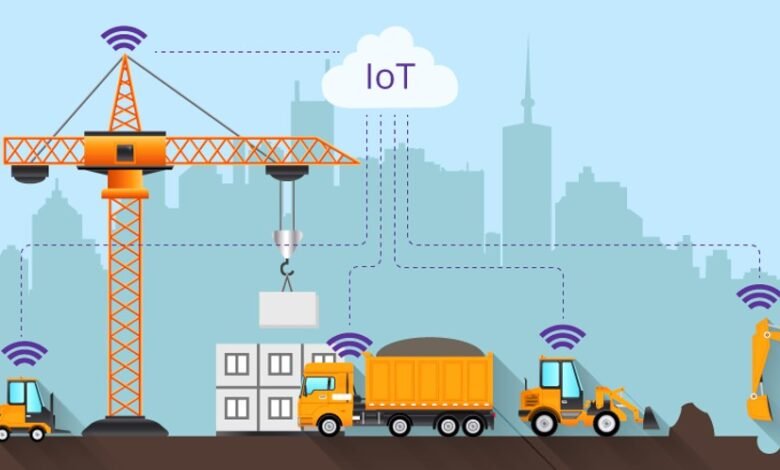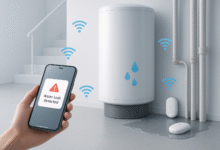5 Innovative Applications of IoT in Construction
Traditionally, the construction sector has lacked a strong technological focus, although this is evolving.

Traditionally, the construction sector has lacked a strong technological focus, although this is evolving.
Due to extensive delays and rising expenses, an increasing number of companies are adopting technologies such as the Internet of Things (IoT) for assistance.
With the growth of that tendency, numerous beneficial applications of IoT in construction have arisen.
The application of IoT technologies in construction is relatively young; however, initial use cases demonstrate considerable potential.
This document presents five innovative applications of this technology within the construction industry.
5 Applications of IoT in Construction
#1: Wearables
Wearables are among the most recognized IoT devices for many individuals and are very beneficial in the construction industry.
Smart helmets and connected work boots are increasingly appearing on construction sites, thereby enhancing safety and efficiency.
Over twenty percent of occupational fatalities occur in the construction sector; however, wearable technology can assist by notifying workers of dangerous conditions.
Connected helmet sensors can track heart rates and body temperature to identify when employees are at risk of overexertion and alert them to take a break.
Proximity sensors may alert workers when they near fall hazards or heavy gear, averting accidents. Wearables assist construction workers in maintaining efficiency.
These devices offer location functionalities, enabling administrators to ascertain the whereabouts of individuals at all times. Data from these sensors can identify the most significant inefficiencies, guiding workflow modifications.
#2: Safety Sensors
On-site or on-vehicle safety sensors represent a comparable implementation of IoT in construction, yielding substantial advantages.
Similar to how wearables offer valuable safety insights on individual workers, these devices can similarly provide pertinent information about the entire worksite.
Approximately 75 percent of struck-by incidents involve heavy machinery. IoT sensors on this equipment can notify operators or autonomously halt the operation if proximity to another worker is excessive, so preventing mishaps.
Maintenance sensors can alert crews when equipment requires repair, thereby decreasing the risk of breakdowns or malfunctions that could jeopardize surrounding employees.
On-site IoT sensors can detect hazards such as poisonous gases or elevated temperatures. When these measurements attain hazardous levels, these systems notify employees to evacuate or suspend their activities, therefore averting accidents.
Related: How IoT is Affecting Construction Jobsites
#3: Material Monitoring
Construction sites may utilize IoT devices to oversee their materials. Concrete sensors represent a significant example.
By integrating linked sensors within concrete, construction teams can remotely monitor the curing process or assess the necessity for repairs.
Due to variations in temperature and humidity, there is no assured timescale for the completion of concrete curing.
By utilizing IoT devices for process monitoring, teams can prevent premature initiation or excessive delays, hence optimizing project completion schedules.
These technologies can assist in monitoring the infrastructure’s condition post-project completion.
Connected sensors can notify building owners or infrastructure authorities of fractures or deteriorating concrete in real time, enabling prompt intervention to prolong its lifespan.
#4: Theft Prevention
The prevention of theft is an expanding application of IoT in the construction industry. Construction sites are major targets for theft due to their valuable equipment and comparatively inadequate security measures.
As the costs of construction materials increase, the incidence of theft may increase; nevertheless, IoT devices assist in combating this issue.
Interconnected drones can monitor worksites autonomously, eliminating the necessity for a human security staff.
These gadgets can deter potential thieves as they navigate the area, and if theft occurs, their video recordings can assist in identifying the perpetrators.
Location sensors in machinery can also be beneficial. IoT trackers can relay the real-time location of a car or tool without notifying the individual who has taken it.
Construction firms or law enforcement agencies can subsequently locate and retrieve the pilfered items.
Related: IoT in Manufacturing: Towards a Smarter Future
#5: Waste Management
Construction teams utilize IoT technologies to monitor and reduce their waste. In 2018, construction and demolition activities produced 600 million tons of garbage, excluding wasted fuel and other forms of energy.
IoT tracking offers the industry the necessary insights to diminish that statistic. Data from car tracking systems can disclose suboptimal usage practices.
Construction teams can subsequently modify their operations, thereby reducing fuel use. Implementing analogous solutions on more equipment will produce equivalent advantages for energy use.
IoT sensors can monitor on-site garbage levels, identifying sources of extra rubbish to inform more efficient procedures in the future.
These solutions facilitate the maintenance of clear construction sites, thereby enhancing safety and promoting more efficient on-site operations.
Applications Continue to Grows
These five examples represent a fraction of the numerous applications of IoT in construction. As an increasing number of organizations engage in this technology, novel applications and advantages emerge concurrently.
As these trends persist, the Internet of Things (IoT) might significantly transform the future of the construction sector.











